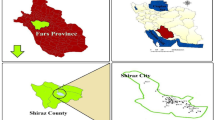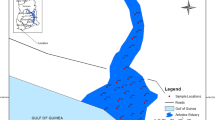Abstract
This paper describes the application of two multimedia models, PRESTO and MMSOILS, to predict contaminant migration from a landfill that contains an organic chemical (methylene chloride) and a radionuclide (uranium-238). Exposure point concentrations and human health risks are predicted, and distributions of those predictions are generated using Monte Carlo techniques. Analysis of exposure point concentrations shows that predictions of uranium-238 in groundwater differ by more than one order of magnitude between models. These differences occur mainly because PRESTO simulates uranium-238 transport through the groundwater using a one-dimensional algorithm and vertically mixes the plume over an effective mixing depth, whereas MMSOILS uses a three-dimensional algorithm and simulates a plume that resides near the surface of the aquifer.
A sensitivity analysis, using stepwise multiple linear regression, is performed to evaluate which of the random variables are most important in producing the predicted distributions of exposure point concentrations and health risks. The sensitivity analysis shows that the predicted distributions can be accurately reproduced using a small subset of the random variables. Simple regression techniques are applied, for comparison, to the same scenarios, and results are similar. The practical implication of this analysis is the ability to distinguish between important versus unimportant random variables in terms of their sensitivity to selected endpoints.
Similar content being viewed by others
REFERENCES
EPA, Superfund Public Health Evaluation Manual, EPA/ 540/1-86/060 (1986).
EPA, Risk Assessment Guidance for Superfund, Human Health Evaluation Manual Part A. EPA/540/1-89/002 (1989).
EPA, Methodology for Assessing Health Risks Associated with Indirect Exposure to Combustor Emissions, EPA/600/ 6-90/003, Cincinnati, Ohio (1990).
EPA, Human Health Evaluation Manual, Supplemental Guidance: Standard Default Exposure Factors, OSWER Di-rective 9285.6-03, Washington, DC (1991).
EPA, Dermal Exposure Assessment: Principles and Applica-tions, EPA/600/8-91/011B. Washington, DC (1992).
EPA, Integrated Risk Information System (IRIS), Office of Research and Development, Environmental Criteria and As-sessment Office, Cincinnati, Ohio (1994).
EPA, Health Effects Assessment Summary Tables (HEAST), EPA/540/R-94/020, Washington, DC (1994).
EPA, Region IX Preliminary Remediation Goals (PRGs), San Francisco, California (1994).
T. E. McKone and K. T. Bogen, “Predicting the Uncertainties in Risk Assessment—A California Groundwater Case Study,” Environmental Science and Technology 25(10)1674–1681(1991).
EPA, Policy for Use of Probabilistic Analysis in Risk Assess-ment at the U.S. Environmental Protection Agency, Risk Assessment Forum, EPA/630/R-97/001 (1997).
D. M. Hamby, “A Review of Techniques for Parameter Sensi-tivity Analysis of Environmental Models,” Environmental Monitoring and Assessment 32(2)135–154(1994). Kluwer Academic Publishers, Netherlands.
J. C. Helton, J. D. Johnson, M. D. McKay, A. W. Shiver, and J. L. Sprung, “Robustness of an Uncertainty and Sensitivity Analysis of Early Exposure Results with the MACCSReactor Accident Consequence Model,” Reliability Engineering and System Safety 48129–148. (1995). Elsevier Science Limited, Northern Ireland.
R. D. Manteufel, “Variance-Based Importance Analysis Ap-plied to a Complex Probabilistic Performance Assessment,” Risk Analysis 16(4)587–598(1996).
J. Kalagnanam, M. Kandlikar, and C. Linville, “Importance Ranking of Model Uncertainties: A Robust Approach,” IBM Research Report, RC 21130(94479), T. J. Watson Research Center, Yorktown Heights, New York (1998).
C. Y. Hung, User's Guide for PRESTO-EPA-CPG Operation System, Version 2.1, U.S. Environmental Protection Agency, Office of Radiation and Indoor Air, Washington, DC (1996).
EPA, MMSOILS: Multimedia Contaminant Fate, Transport, and Exposure Model. Documentation and User's Manual Version 4.0, Draft, Prepared for Environmental Research Laboratory, U.S. Environmental Protection Agency, Athens, Georgia (1996).
G. F. Laniak, J. G. Droppo, E. K. Gnanapragasam, W. B. Mills, D. L. Strenge, G. Whelan, and C. Yu, “An Overview of a Multimedia Benchmarking Analysis for Three Risk As-sessment Models: RESRAD, MMSOILS, and MEPAS,” Risk Analysis 17(2)203–214(1997).
W. B. Mills, J. J. Cheng, J. G. Droppo, E. R. Faillace, E. K. Gnanapragasam, R. A. Johns, et al.“Multimedia Bench-marking Analysis for Three Risk Assessment Models: RESRAD, MMSOILS, and MEPAS,” Risk Analysis 17(2)187–201(1997).
EPA, Exposure Factors Handbook, EPA/600/P-96/002A, Washington, DC (1996).
G. W. Snedecor and W. G. Cochran, Statistical Methods7th ed. (The Iowa State University Press, Ames, Iowa, 1967).
Author information
Authors and Affiliations
Rights and permissions
About this article
Cite this article
Mills, W.B., Lew, C.S. & Hung, C.Y. Sensitivity of Concentration and Risk Predictions in the PRESTO and MMSOILS Multimedia Models: Regression Technique Assessment. Risk Anal 19, 511–525 (1999). https://doi.org/10.1023/A:1007013015263
Issue Date:
DOI: https://doi.org/10.1023/A:1007013015263




